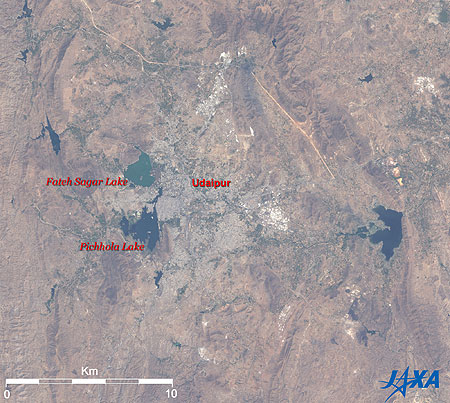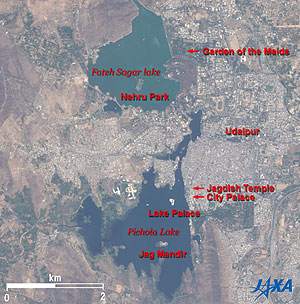Seen from Space 2007
Palace on Lake, Udaipur
Lake Pichola is at the bottom (south) of the figure, and Fateh Sagar Lake is at the top (north). Lake Pichola is 4km by 3km wide. Jag Niwas Island is the white palace visible in the upper part of the figure. Lake Palace was built as a summer detached palace by the Maharana. Almost the entire island is made of marble and is now utilized for a hotel. It was the location for shooting the "007 Octopussy" film. Jag Manidr Island, in southern Lake Pichola, has a palace where Emperor Shah Jahan of the Mughal Empire once lived. Fateh Sagar Lake was made when the dam burst due to heavy rain in 1678. Maharana Fateh Singh subsequently rebuilt and extended it. The large island in the middle of Fateh Sagar Lake is Grand Nehru Park, named after first prime minister Nehru. It has a flower garden and lotus pond. Udaipur Solar Observatory is also located in the middle of the lake and is one of the best locations in the world for observing the Sun. It is better suited for observing the Sun because there is little disturbance due to the Earth's heat and atmospheric scattering because it is located on the lake. These lakes are weather-sensitive areas and have suffered heavy rains and droughts many times. Recently, there was heavy rain in 1975, and then lakes dried up in 2003 and 2005. People walked through the Observatory and Lake Palace after it had dried up. You can see from Fig. 2 that there is a lot of water this year. Standing on the east bank of Lake Pichola is the City Palace where the Maharana currently lives. It was repeatedly extended and reconstructed until it has become the largest palace in Rajasthan state, measuring 240m east to west and 450m north to south. The palace is rich with marble and is open to the public as a museum. Jagdish temple situated in the entrance of the City Palace was constructed in an Indo-Aryan architectural style by Maharana Jagdish Singh in 1651. This temple is devoted to the Hindu God Vishnu, and the black stone, Jagannath, means the supreme god is enshrined. You can see the Garden of the Maidens, Saheliyon-ki-Bari, on the east bank of Fateh Sagar Lake. This was built by Maharana Sangram Singh in the 18th century. This garden was a popular spot where royal ladies and maids came for picnics. The garden has beautiful landscaping with many fountains, kiosks, marble elephants, and lotus pools. However, the fountains are operated only for visitors.
|






